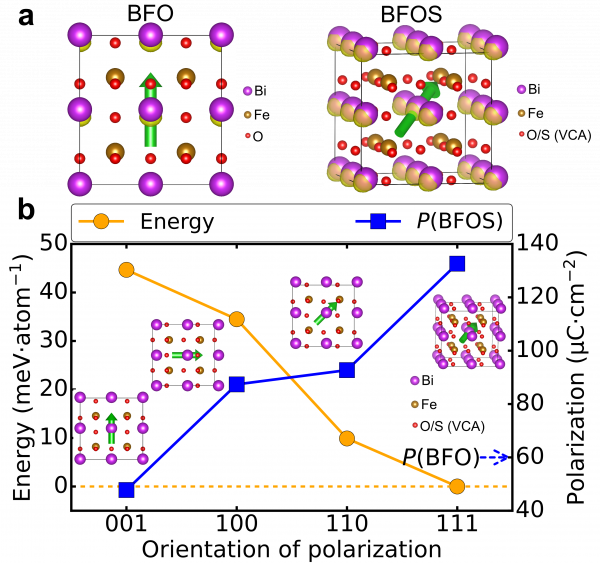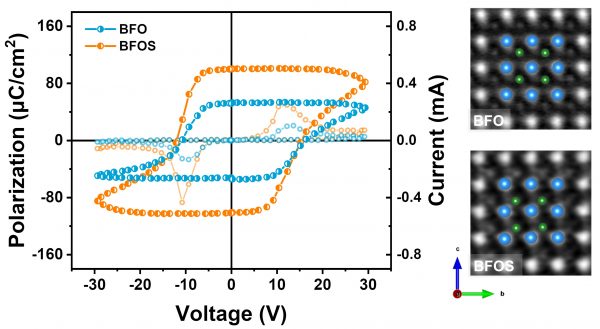Amplifying Ferroelectricity: Sulfurization Unveils New Potential in Oxide Memory Materials
- Following up the breakthrough in designing atomic-thick ferroelectrics [SCIENCE 379, 1218 (2023)] in March 2023, the researcher Yue-Wen Fang at Centro de Física de Materiales (CSIC-UPV/EHU), together with the experimental team led by Linxing Zhang at the University of Science and Technology Beijing and Zhao Pan at Institute of Physics Chinese Academy of Sciences, has made another progress in ferroelectric materials. In this work, they report that the sulfurization can significantly enhance the ferroelectricity in the extensively studied multiferroic material BiFeO3 (by 1.7 times).
- The research findings have been published online in the journal Mateirlas Horizons, where Zhao Pan, Yue-Wen Fang and Linxing Zhang are the corresponding authors.
Reference: “Anion-induced robust ferroelectricity in sulfurized BiFeO3 thin films via polarization rotation”
Bismuth ferrite, BiFeO3 (BFO), is undoubtedly the most widely studied multiferroic materials in which ferroelectric order coexist with the ferroelectricity. In the latest years, many methods have been propsoed to enhance the room-temperature ferroelectricity in order to achieve higher performance in room-temepreature information storage devices.
The researchers in this study have used first-principles to predict that the introduction of sulfur atoms at the anions sites of BFO can be used to manipulate the polarization rotation, which plays a crucial role in controlling the electronic structure and properties of BiFeO3. Rotation of the polarization state from the [001] direction to the [110] or [111] direction is a result from a redistribution of the lone-pair electrons of Bi, as evidenced in Fig. 1.

Figure 1. (a) The visualization of lone-pair electrons for pristine BFO and BFOS by electron localization function; (b) The total energy (orange circles) and the magnitude of ferroelectric polarization (blue squares) as a function of the orientation of ferroelectric polarization of BFOS.
Guided by the theoretical predictions, the experimental teams synthesized the BFO thin films. By introducing sulfur anions, they successfully sulfurized BiFeO3 thin films, and found the sulfurized films exhibited a remarkable 170% increase in remnant polarization, from 58 to 100.7 microcoulombs per square centimetre (see Fig. 2).

Fig. 2 The significantly enhanced ferroelectricity (left panel) and the induced polarization rotation due to sulfurization.
The findings have significant implications for the field of ferroelectric materials. The ability to induce polarization rotation through anion substitution provides a promising avenue for enhancing the performance of various oxide perovskite materials. By applying this method, researchers may be able to realize new states of matter and phenomena, leading to the development of highly functional materials with improved properties.
The study also highlights the importance of anion substitution in oxide perovskites, an area that has received less attention compared to cation substitution. Among various anions, sulfur stands out as a suitable candidate due to its similar valence electron configuration to oxygen. The substitution of sulfur atoms on the oxygen sites avoids the introduction of undesirable holes or defects, leading to enhanced ferroelectricity in perovskite films.
This progress in the field of ferroelectric oxides could also be applicable to other functional oxide materials. As further research builds upon these findings, scientists and engineers may unlock the full potential of oxide materials, leading to significant advancements in numerous technological areas.



